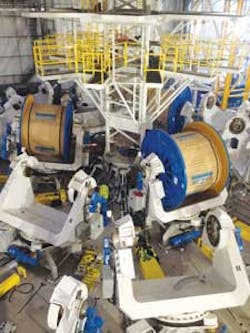Jeremy Beckman
Editor, Europe
Asdeepwater projects become increasingly larger in scope and with longer-distance step-outs, the onus is on subsea equipment manufacturers to speed up production to deliver their higher-volume orders on schedule.
Technip Umbilicals, formerly known as DUCO, Ltd., has responded by upgrading the steel tube manufacturing process at its complex in Newcastle northeast England. The centerpiece is a new multi-level, 58-m (190-ft) high vertical helix assembly machine (VHAM) housed within a purpose-built building claimed to be one of Europe's tallest. It will be able to manufacture larger-diameter and more complex umbilicals, including consignments forEgina and Moho, two of Total's current deepwater mega-projects off West Africa.
The VHAM is based on the same concept as the plant operating in Houston, but in a vertical format that accommodates more and larger bobbins that provide a substantial increase in production capacity and the capability to produce in larger, continuous lengths.
According to Jean-Louis Rostaing, managing director of Technip Umbilicals, features of the new machine include continuous optimized tension during pay-off from the bobbins (previously tension had to be pre-set), leading to a more even tension throughout the umbilical.
Other innovations are a tube welding and cable joining station designed to produce longer lengths; a six-laser head system that provides continuous measurement of the product's outside diameter; advanced safety sensors; and ergonomically-designed workstations that minimize manual handling.
The VHAM will be able to produce several hundred umbilicals each year and bundles in diameters of up to 45 cm (17¾ in), although bundles of this size are unlikely to be needed for the foreseeable future. Complimentary investments are a brand new polymer extrusion line and two new large-diameter carousels north and south of the VHAM that can store up to 3,500 tons of long-length, heavy umbilicals. These can be transferred on a roller track system to Technip's deepwater quay for spooling directly onto installation vessels. Alternatively umbilicals can be stored on 12-m (39-ft) diameter reels storing up to 350 tons of product that can be lifted directly onto the vessels.
In the VHAM, umbilical assembly starts at the bottom and continues upward. Below the machine a deep pit houses roller path guides which convey either the large-bore (2-4-in.) superduplex center tube or the first pass bundle of components upward into the center of the VHAM's chain-driven revolving deck. This is done with a gentle curve, compared with Technip's existing machines at the Newcastle complex, to minimize bending. From the area of the control cabin on Level 1, the tubes are drawn up into the center of the VHAM using straighteners from counter-rotating, tension- controlled bobbins. The higher-capacity bobbins receive and pay out steel tube, electrical, and fiber optic cables while the smaller-diameter bobbins house the various filler components that will be applied between the tubes.
Level 2 also houses the steel tube section welding deck and a digital X-ray room for weld analysis. According to R&D business development manager Ian Probyn the welding process can be fully automated, depending on the required welding procedure.
On Level 3, the tubes are bent on pre-forming rollers into a helical shape for incorporation into the umbilical bundle. On levels 4 and 5, the lay plate positions all the components to the correct part of the bundle and brings them together in an even form. The taping deck on Level 6 is where the bundle is wrapped in fiber-reinforced tape. The four tape heads, enclosed in a soundproof booth, are up to 1.1 m (3.6 ft) in diameter. A Trafalgar box above and below centralizes the bundle as it enters and exits the tape head via a series of rollers – built-in sensors monitor tension and potential tape breakage.
Levels 7 and 8 house two pairs of 30-ton, 3.5-m (11.5-ft) long caterpillar tensioners with 2 m (6.6 ft) contact length – the four-track configuration is unique, according to Probyn – providing maximum pull load for the largest tubes. A 15-ton winch pulls through the center bundle during set-up. On Level 9, six laser heads measure various points around the full circumference of the bundle, ensuring it is within tolerance. "It is important to keep all the steel tubes within their elastic limit," he explains, "so that when you bend them, you control and minimize plastic deformation as this maximizes quality." The bundle is then directed on guide rollers around 9-m (29.5-ft) radius swan necks, via a diverter, to either the north or south carousel down through a safety containment tube.
"There is no metal-to-metal contact between the steel tubes," Probyn points out. "They are separated by a polymer layer: this avoids the risk of abrasion or contamination caused by carbon steel contacting superduplex, which can lead to corrosion. The lean duplex tubes have a zinc coating for corrosion resistance."
The second part of the process is the sheathing line (in the same building as the VHAM), where the bundle receives its outer protective jacket. Here, there are 7.5-metric ton (8.2-ton) tensioners for pay off and take up of the umbilical and tube. First, the bundle passes through a dryer which removes the moisture to achieve a good-quality oversheath. It then passes through caterpillar tensioners, designed to maintain tension and to check for any slippage, and on through the extrusion machine head. "Whereas for flexible pipes, the outer sheath acts as a pressure barrier, for umbilicals the sheath is a free-flooding mechanism with holes punched to encourage free flooding."
Finally the bundle is transferred to two cooling baths that ensure progressive cooling along the length of the product: the first applies a high-pressure spray that forms a skin on the surface of the bundle, while the second is an immersion bath designed to cool the bundle from 100° to 30°C (212° to 86°F). Six laser heads then perform measurements of the umbilical's diameter, with further measurements taken of wall thickness and length.






